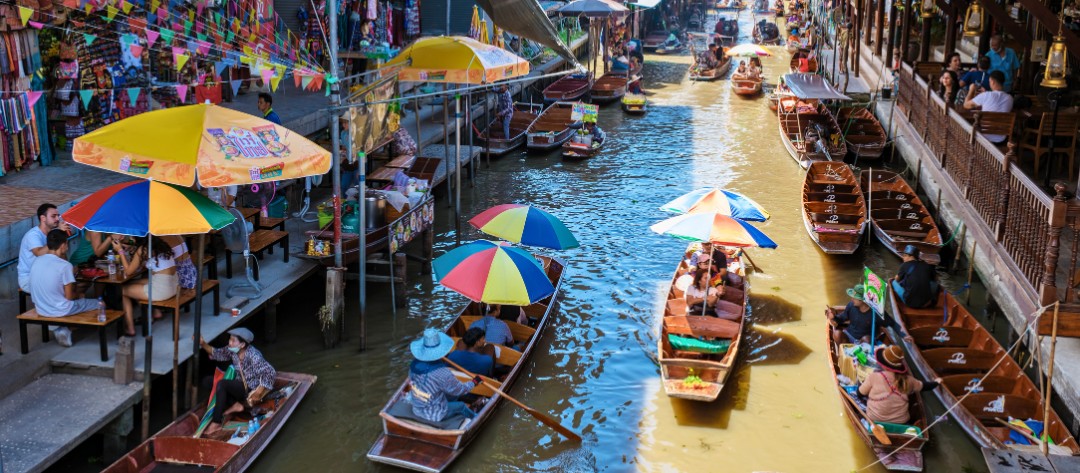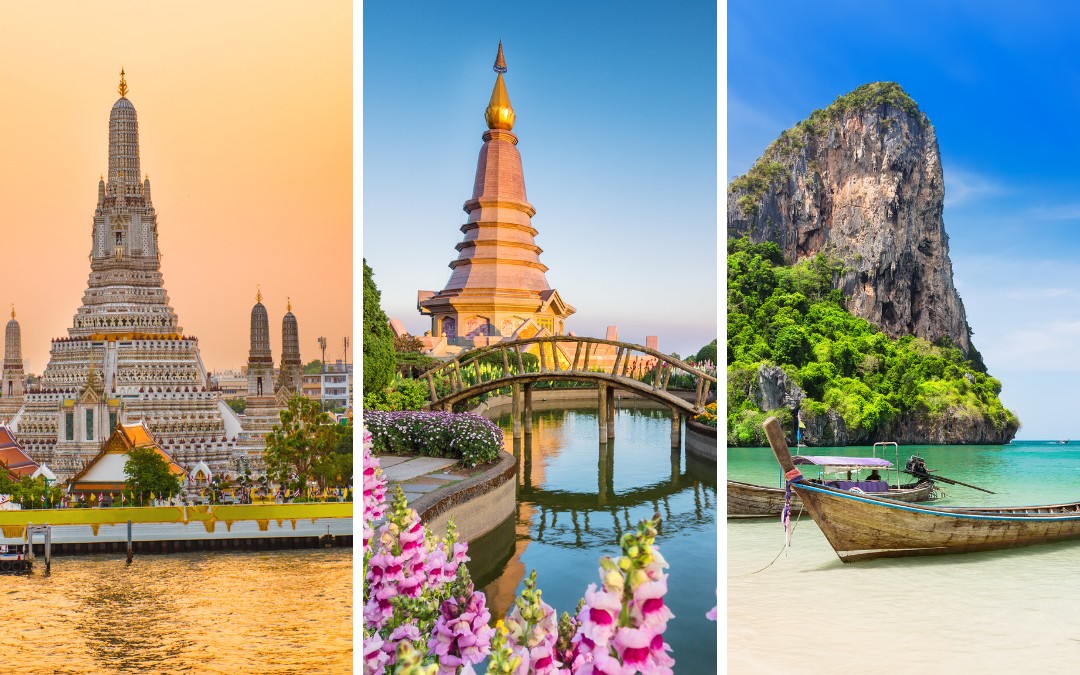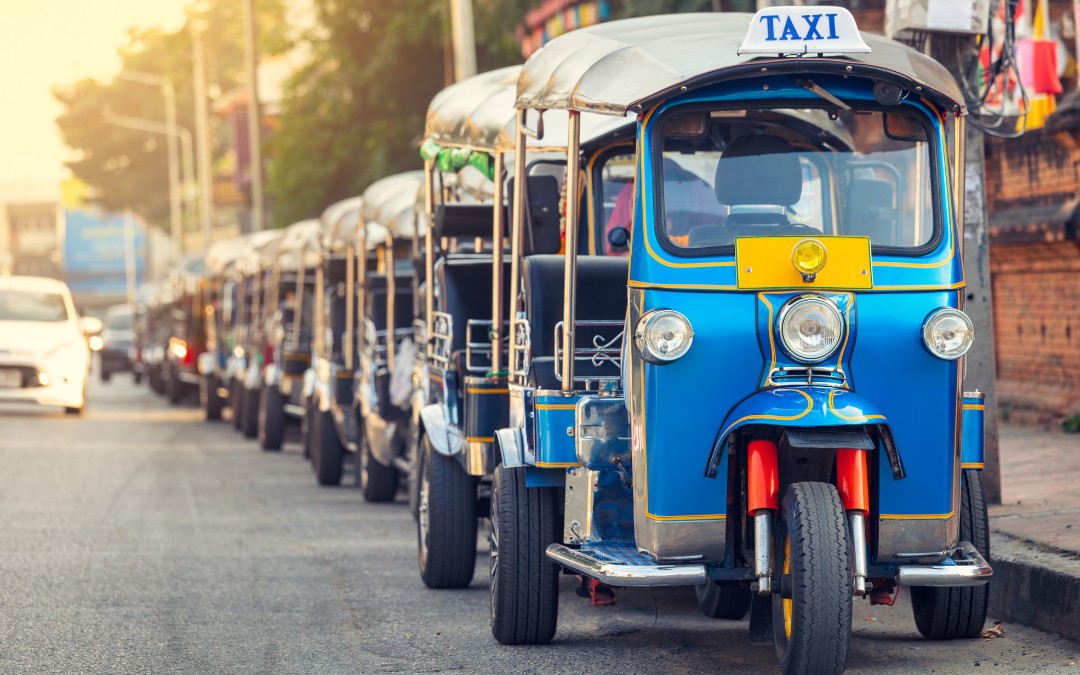How To Plan A Trip To Thailand: A 7-Step Guide For First-Timers

Dreaming of Thailand’s palm-fringed beaches and vibrant street markets? Planning a trip to this tropical paradise is easier than you might think. With our straightforward guide, you’ll discover the essentials on how to plan a trip to Thailand, ensuring you soak up every moment of your upcoming adventure. From the golden temples of Bangkok to the tranquil islands of the Andaman, let’s dive into the details that will turn your Thai travel dreams into reality.
How To Plan A Trip To Thailand Guide
Step 1: Select Your Destinations In Thailand
Thailand is a country of diverse landscapes, each with its own unique allure. Choosing your destinations is the first step in your Thai adventure, from bustling cities to peaceful natural sites. Check out some of the main destinations and areas, along with suggestions based on different interests.
- Bangkok
As the pulsating heart of Thailand, Bangkok is a thrilling blend of historical grandeur and urban hustle, a city that will captivate your senses and leave you breathless.
From the sacred Wat Phra Kaew with its awe-inspiring architecture and the iconic Emerald Buddha, to the vibrant and bustling Khao San Road with its fascinating blend of colors, flavors, and sounds, Bangkok offers an exceptional adventure. This city is a must-visit destination for travelers seeking a deep dive into Thai culture, tantalizing street food, and a glimpse into the country’s soul.

Grand Palace in Bangkok
>> Read More: 15 Best Things To Do In Bangkok With Kids
- Chiang Mai
Nestled in the mountainous region of Northern Thailand, Chiang Mai is the spiritual and cultural nucleus that offers a more laid-back atmosphere compared to Bangkok. Known for its beautiful temples like Wat Phra Singh, elephant sanctuaries, and night markets, Chiang Mai appeals to those looking for cultural immersion and natural escapes.
>> See Tour: Northern Thailand Adventure & Pristine Beach
- Phuket
Thailand’s largest island, Phuket, is synonymous with beach paradise. Travelers can enjoy their best time on a stunning coastline, clear turquoise waters, and vibrant nightlife. Patong Beach, with its buzzing atmosphere, is perfect for party-goers, while Kata and Karon Beaches offer a more relaxed vibe, making it ideal for families and couples.
>> Read More: Best 20 Places To Explore In Phuket For Families & Couples
- Krabi Province
Krabi offers some of Thailand’s most iconic landscapes, with towering limestone cliffs and pristine beaches. Destinations such as Railay Beach and the Phi Phi Islands offer incredible rock climbing and diving opportunities. Krabi is perfect for adventure seekers and those looking to indulge in the quintessential postcard-perfect scenery of Thailand.
- National Park Enthusiasts
For those who cherish the great outdoors and wildlife, Khao Yai National Park is a treasure trove of lush forests, majestic waterfalls like Haew Narok, and a plethora of wildlife, including elephants and exotic birds. It’s a perfect escape for nature lovers and photographers.
- Island Explorers
The islands of Thailand are like pearls scattered across the ocean. Koh Samui offers a blend of luxury resorts and coconut palm-fringed beaches, while Koh Tao is a diver’s paradise with rich marine life. For a more secluded island experience, Koh Lanta provides a laid-back vibe with long, quiet beaches.

Thailand’s famous islands: Koh Samui and Koh Tao
>> Read More: Top 5 Islands In Thailand That You Cannot Miss
- Cultural/History Hub Seekers
Ayutthaya, the ancient capital of Siam, is a historical sanctuary just a short trip from Bangkok. Here, you can wander through the ruins of once-magnificent temples and palaces. Similarly, Sukhothai Historical Park invites history buffs to explore the birthplace of Thai art, language, and architecture in a tranquil setting.
>> Get more travel ideas from this article: 13 Best Places To Visit In Thailand For First Timers
Step 2: Determine the Length of Your Stay
The duration of your trip to Thailand can greatly influence the destinations you choose to visit and the depth of your experiences. Let’s break down your potential itinerary by the length of your stay.
- 3-4 days: A brief glimpse
If you have just a few days, focus on exploring one area to avoid spending too much time in transit.
If you choose Bangkok, this option can provide a snapshot of Thailand’s culture, cuisine, and chaos. There would be enough time for you to visit iconic sites such as the Grand Palace or Wat Arun and to take a cruise on the Chao Phraya River.
Alternatively, if you’re looking for a quick beach getaway, consider a direct flight to Phuket or Krabi to unwind on the stunning beaches.
- 1 week: A taste of the variety
For a week, you can comfortably explore two to three locations.
Start in Bangkok for a couple of days, then head north to Chiang Mai to experience the cultural heritage and cooler climate.
If the beach is calling, you could alternatively spend a couple of days in Bangkok followed by a flight to Koh Samui or Phuket, leaving time to possibly include a day trip to nearby islands such as Koh Phi Phi or Koh Tao.
- 2-3 weeks: The full spectrum
An extended stay allows for a more comprehensive tour of Thailand.
Begin your journey in Bangkok, then travel north to Chiang Mai and possibly Chiang Rai, soaking in the cultural sights. Next, head south to explore the varied landscapes and relax on the beaches of the Thai islands, choosing from Phuket, Krabi, Koh Samui, or the less touristy Koh Lanta.

A suggestion for your route: Bangkok – Chiang Mai – Phuket
Round out your trip with a visit to a national park like Khao Sok for an adventure amidst rainforests and limestone karsts, or take a historical detour to Ayutthaya or Sukhothai to marvel at Thailand’s storied past.
Step 3: Timing Your Thai Trip
Finding the sweet spot for your travel dates to Thailand can make all the difference in your experience. Let’s not state which season is the best since you need to plan the trip based on your own schedule.
Instead, here’s information about different seasons in Thailand so that you can make the final decisions yourself.
- Dry Season (November to March)
The most popular time to visit is the dry season, from November to March, which offers pleasant temperatures and minimal rainfall. This period is perfect for exploring the cultural sites and enjoying the beaches. However, it’s also peak tourist season, so expect larger crowds and higher prices.
- Shoulder Seasons (late October and early April)
To enjoy good weather while avoiding the tourist rush, consider the shoulder months of late October and early April. You’ll still catch the favorable climate but with fewer people, which can translate to lower costs and a more relaxed atmosphere.
- Festive Rush (Christmas and New Year)
The festive season sees a significant surge in visitors. Accommodations in hotspots like Bangkok and Phuket, as well as flights on popular routes, such as Chiang Mai to Phuket, get booked quickly. Planning at least six months ahead can secure you better rates and ensure your spot.
- Monsoon Travel (August to December)
If you don’t mind the rain, traveling during the monsoon season comes with its perks. In Phuket, the monsoon runs from August to September, while Koh Samui experiences it from October to December. These periods promise fewer tourists, more affordable prices, and a different perspective on the lush landscapes, but be ready for periodic showers that could alter your plans.

Tropical monsoon rain in Krabi
>> Read More: Best Time To Visit Thailand
Step 4: Budget for the Trip
Thailand’s affordability is a big draw for travelers, with a range of options to suit any budget. While the international airfare to Thailand is the most significant cost you’ll face, once you land, the country caters to all financial plans.
- Accommodation
There are a plethora of lodging options to choose from, ranging from budget-friendly hostels and guesthouses starting at a few dollars per night to luxurious resorts offering opulence and exclusivity at a premium price.
- Food
Satisfy your taste buds with mouth-watering street food that won’t break the bank, or indulge in a luxurious gourmet meal at a high-end restaurant.
- Activities
There’s no shortage of free activities, such as exploring temples or lounging on beaches. Conversely, guided tours and special excursions will add to your budget.
It’s wise to set a daily budget to keep your spending in check. On a medium budget, you might expect to spend around 150–200 USD per day, including nice 4-star hotels, in-country flights, attractions, guides, and transfers. For those seeking more luxury, a daily budget of 200–250 USD provides 5-star accommodations and additional comforts.
For families traveling for two weeks, costs can range from 10,000–15,000 USD, not including international flights. This estimate provides a good benchmark for planning your family’s adventure.
Step 5: Guided Tours or Solo Exploration?
When deciding between a guided tour and going solo, consider what you want from your trip and how much effort you’re willing to put into planning.
- Solo Travel
Independent travel in Thailand is entirely achievable, especially for those who love the thrill of navigating a new country on their own. This option allows for flexibility and the chance to explore spontaneously. However, it can be time-consuming to research and book accommodations, identify the best activities, and ensure you’re getting the best value.

Exploring Thailand on your own
- Guided Tours
A private tour in Thailand is a feasible indulgence. With a guided tour, you’re buying convenience, in-depth knowledge, and the efficiency of having your itinerary professionally managed. Prices are reasonable, especially when you consider the benefits of having a personal guide and the time you save on planning.
For the best of both worlds, consider a hybrid approach. You could book a few guided tours for specific experiences or regions you’re unfamiliar with, while leaving the rest of your trip open for independent exploration.
Step 6: Check Visa Requirements
Before planning the specifics of your trip, it’s important to understand the visa requirements for Thailand.
Nationals from many countries, including the United States, Australia, Canada, the United Kingdom, and those from SEA region (like Vietnam, Cambodia, Laos, etc) can enter Thailand without a tourist visa for stays up to 30 days.
This visa exemption makes it convenient for many travelers to visit Thailand on a short-term basis. However, if you plan to stay longer, you will need to apply for a visa in advance.
Always check the latest visa requirements and ensure your passport has at least 6 months of validity from the date of entry into Thailand.
>> Read More: Thailand Travel Requirements – Latest Updates
Step 7: Plan Your Arrival and In-Country Travel
Getting to Thailand
- From North America
Expect to have at least one stopover when flying from North America. Common layover cities include Seoul, Tokyo, Hong Kong, Taipei, and Dubai. Each offers a range of airlines and transit experiences, so it’s worth researching your options to find a balance between cost, travel time, and comfort.
- From Europe and Oceania
Direct flights are more readily available from major cities in Europe and Oceania to Bangkok. This direct access can simplify your travel plans and journey.
- From other SEA countries
Suvarnabhumi Airport in Bangkok is a major Southeast Asian travel hub with frequent flights to neighboring countries like Vietnam, Cambodia, Myanmar, and Laos. Leveraging Bangkok’s connectivity can facilitate a comprehensive Southeast Asian tour.
Traveling Around Thailand

Tuk-tuks are popular taxis in Thailand
Once you’re in Thailand, there are several transportation options to navigate the country:
- Domestic flights: For long distances or if you’re short on time, consider flying. Thailand has several budget airlines that offer frequent and affordable services between major cities and tourist destinations.
- Trains: Thai Railways operates routes connecting Bangkok with other regions, including overnight trains, which are a memorable way to travel. Sleeper trains are particularly popular for their comfort and the experience of waking up to a new part of Thailand.
- Buses: The bus network in Thailand is extensive and can take you almost anywhere in the country. VIP and express buses provide more comfort and are a good choice for longer journeys.
- Vans and Minibuses: Often faster than buses, minibusses are a common way to reach destinations that are not too far from Bangkok or for intercity travel. They can be more cramped but are usually air-conditioned.
- Taxis: In cities, taxis are a convenient way to get around. Make sure the driver uses the meter or agrees on the fare before starting your journey.
- Tuk-Tuks and Motorbike Taxis: For short distances, these are fun options. Be sure to negotiate the price before you hop on.
- Rental cars and Bikes: For more freedom, consider renting a car or motorbike. Be sure to have an international driving permit and be comfortable with local driving habits.
- Public transportation in Bangkok: The BTS Skytrain and MRT Subway are efficient ways to avoid traffic in the capital city. The Chao Phraya River boats offer scenic routes between key tourist spots.
- Bicycles: In rural areas or for touring specific regions like Sukhothai or Chiang Mai’s old city, bicycles are a pleasant and eco-friendly option.
More Tips For An Amazing Holiday In Thailand
When planning a trip to Thailand, here are some additional tips to ensure you have an unforgettable experience:
Embrace Local Etiquette
- Mind your manners
The ‘wai’ greeting (a slight bow with palms pressed together) is a respectful way to greet locals. Avoid touching someone’s head, as it’s considered the most sacred part of the body, and try not to point your feet towards people or religious objects, as feet are considered the lowest part.
- Respect the culture
Thai culture is steeped in tradition and respect, especially towards the monarchy and religion. Dress modestly when visiting temples, and always remove your shoes before entering someone’s home or a place of worship.

Songkran ceremony in Thailand
Stay Connected
Upon arrival, consider purchasing a Thai SIM card for your mobile phone. They’re affordable and provide access to data and local calls, making it easier to navigate, translate, and stay in touch with tour operators or your accommodations.
Health and Safety
- Stay hydrated
The Thai climate can be hot and humid. Drink plenty of bottled water to stay hydrated, and use sunscreen regularly.
- Street food
Thai street food is delicious and generally safe to eat. However, choose stalls that are busy and appear to have a high turnover of food to ensure freshness.
- Travel Insurance
It’s always wise to have comprehensive travel insurance that covers medical expenses, trip cancellations, and any adventurous activities you might undertake.
Explore Beyond the Tourist Spots
- Off the beaten path
While famous sites like the Grand Palace in Bangkok or the beaches of Phuket are must-sees, consider exploring less touristy areas to get a feel for the ‘real’ Thailand.
- Local transportation
Take local transport like tuk-tuks, songthaews, or even long-tail boats to get around. Not only is it an authentic experience, but it’s also budget-friendly.
Learn a Few Thai Phrases
Although many Thais speak English, particularly in tourist areas, learning a few basic Thai phrases can go a long way in showing respect and can enhance your interactions with locals.
Be Mindful of the Environment
Respect Thailand’s natural beauty by avoiding single-use plastics, not disturbing wildlife, and supporting eco-friendly tours and activities.
Book Your Thailand Holiday with Asia Pioneer Travel
Thailand opens the door to an adventure you’ll never wish to end. For first-timers, every sight, sound, and flavor is an invitation to explore, and every moment is the start of a story you’ll tell for years. So, take a deep breath and prepare to plunge into a world where every experience is as fresh and thrilling as the first.
Asia Pioneer Travel has over 14 years of experience planning incredible Thailand holidays for travelers from all over the world. Share Your Dream Travel Plan With Us, and we will handle everything else to make your trip memorable.



